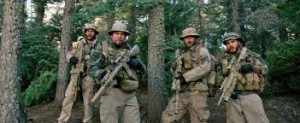 Director Peter Berg is as good as it gets when it comes to putting a particular kind of male chemistry on screen. If he was writing instead of filming, he would dunk his pen in testosterone, beard stubble, and sweat. Whether it is the small town Texas football community of “Friday Night Lights,” the disastrous bachelor party of “Very Bad Things,” or the aliens and explosions of the under-rated “Battleship,” Berg understands the rhythms of guy-talk that circles around the still core of pure masculinity. There are nearly as many f-words per minute in this film as in the record-breaking “Wolf of Wall Street.” But there the language was used to show off, to convey bravado, for shock and awe. Here the heirs to a long tradition of colorful military argot almost have air quotes around the language. It’s almost a mirror image; on Wall Street, they use bad words to seem tougher. These Navy Seals use bad language with irony — they know that no words can be as tough as they really are or express what they have really seen and done. For them, the inadequacy of even the most provocative language is the joke.
Director Peter Berg is as good as it gets when it comes to putting a particular kind of male chemistry on screen. If he was writing instead of filming, he would dunk his pen in testosterone, beard stubble, and sweat. Whether it is the small town Texas football community of “Friday Night Lights,” the disastrous bachelor party of “Very Bad Things,” or the aliens and explosions of the under-rated “Battleship,” Berg understands the rhythms of guy-talk that circles around the still core of pure masculinity. There are nearly as many f-words per minute in this film as in the record-breaking “Wolf of Wall Street.” But there the language was used to show off, to convey bravado, for shock and awe. Here the heirs to a long tradition of colorful military argot almost have air quotes around the language. It’s almost a mirror image; on Wall Street, they use bad words to seem tougher. These Navy Seals use bad language with irony — they know that no words can be as tough as they really are or express what they have really seen and done. For them, the inadequacy of even the most provocative language is the joke.
This is the true story of a disastrous Navy SEAL mission in Afghanistan, based on the book Lone Survivor: The Eyewitness Account of Operation Redwing and the Lost Heroes of SEAL Team 10 by Marcus Luttrell. We know from the title and from the earliest moments of the movie that Luttrell, played by Mark Wahlberg, will be the only one still around at the end of the movie. And so, we steel ourselves, knowing we will spend just enough time with the characters to become attached to them before they are sent off on a doomed mission to take out a ‘bad guy” in Afghanistan and start getting killed.
by Marcus Luttrell. We know from the title and from the earliest moments of the movie that Luttrell, played by Mark Wahlberg, will be the only one still around at the end of the movie. And so, we steel ourselves, knowing we will spend just enough time with the characters to become attached to them before they are sent off on a doomed mission to take out a ‘bad guy” in Afghanistan and start getting killed.
As in most military dramas, real and fictional, there are archetypal characters. There’s a new addition and a hardened vet. And there is Luttrell, a medic, a witness, like Ishmael in Moby Dick the survivor who carries the stories of the others with him.
This is not “action violence,” with super-effective weapons on our side and endless just-misses from the enemy, along with exciting explosions and instant death. This is messy, dirty, blood-gushing and agonizing wartime violence. Berg pays tribute to these men by showing us that their courage, dedication, and skill were unparalleled and the tragic stupidity of war presented them with a series of awful choices and unthinkable danger. At one point, when they have been spotted by (apparent) civilians, including a young boy, they stand there and discuss their options — let them go and risk having them tell the enemy where they are, tie them up and risk having them die of predators or starvation, or kill them, preserving the mission but putting into question the larger issues, from what happens when it gets reported on CNN and what we are fighting for if that is who we’ve become. That may be the most heartbreaking moment of the film — until the end, when we see the real faces of the brave young men who died. They knew what they owed us. Perhaps this movie will help remind us what we owe them.
Parents should know that this movie includes constant wartime peril and violence with many characters injured and killed, children in peril, guns, explosions. There are very disturbing and graphic images of characters being hit with bullets, many sad deaths, as well as constant very strong and sometimes crude language.
Family discussion: What elements of the training and briefings were important to helping the SEALS do their job? What more did they need? Who was right in the discussion of what to do when they were “compromised” in being spotted by civilians?
If you like this, try: “Act of Valor,” with real-life Navy SEALS playing fictional versions of themselves and “We Were Soldiers,” about the early days of the American involvement in the Vietnam War.


